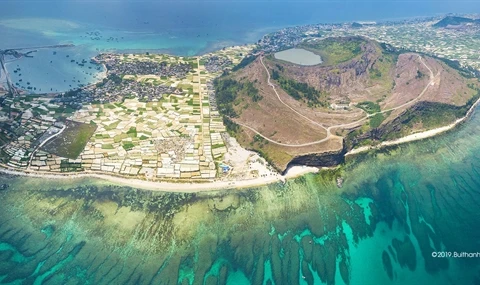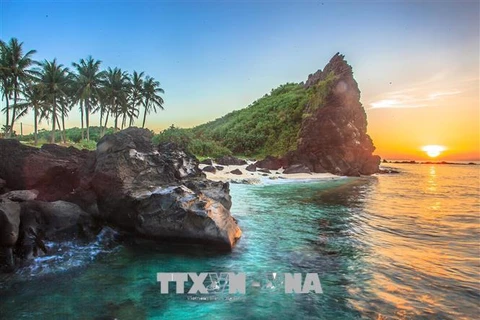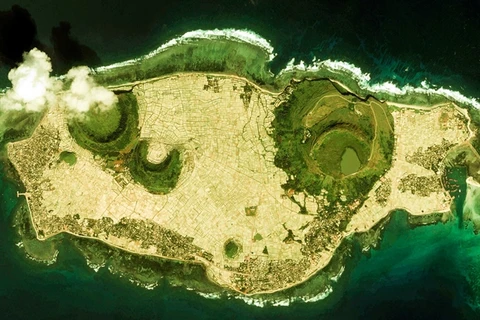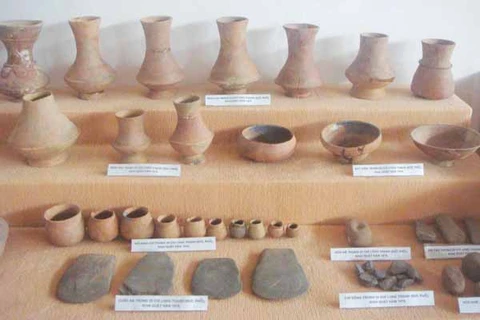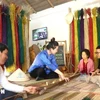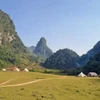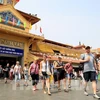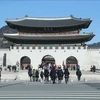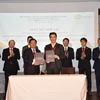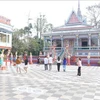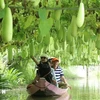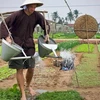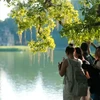 Visitors find a bamboo house with palm thatched roof an interesting part of Go Co village. (Photo: VNA)
Visitors find a bamboo house with palm thatched roof an interesting part of Go Co village. (Photo: VNA) Quang Ngai (VNA) - Boasting untouched beauty, and unique cultural vestiges and traditional practices of Sa Huynh culture, Go Co ancient village in the central province of Quang Ngai is an attractive cultural destination for travelers.
The ancient village is in Pho Thanh ward, Duc Pho town, about 60 km south of Quang Ngai city. The Sa Huynh beach has distinctive golden sand. Go Co is isolated in a valley surrounded by granite that is millions of years old, with its back leaning against the mountain and facing towards the sea.
Surrounded by four mountains – Ganh, Ong Tau, Tru Bo and Ba Quach – the ancient village is naturally protected by the mountains and a downhill valley from natural disasters.
Vestiges of Cham, also known as Champa culture, were excavated 100 years ago by French archaeologists and then Vietnamese researchers in the late 1970s.
Grave jars of the Sa Huynh Culture (1000 BC - AD 200) and steles of Cham people were found in the area, while cliff rocks running to the sea were from ancient dormant volcanoes.
Twelve water wells and stone steles left from the Champa Kingdom were also found here.
The ancient well system has served as a chain to connect Champa and Vietnam cultural traditions.
Co Village, or Go Co, just 2km away from National Highway 1A, is home to nearly 80 percent of Cham people who are old people earning a living from fishing and farming as their forefathers have for generations.
The history and generations-preserved lifestyle and habitat is itself a treasure amid rapid urbanisation. Villagers still preserve an ancient way of life, self-sufficient farming and friendly neighborhood cooperation and treatment in a time that this is rarely seen in rural areas.
Years ago, villagers were suggested to tap the village’s cultural values to improve livelihoods.
Go Co villagers then came to Cham Island in neighboring Quang Nam province to obtain more experience and branch out community-based tourism in 2018.
A community-based eco-tour service cooperative, which involved shareholders from businesses, community, state agencies and local administration was established in Go Co in April 2019. To date, the cooperative has developed 15 standard homestay sites, five tourist boats, five trained tour guides, and eight catering service providers.
According to Director of the cooperative Nguyen Thi Diem, 90% of Go Co villagers have joined the tourism model as they see it as significant to preserve their cultural traditions.
Go Co village was recognised as the first three-star OCOP community-tourism destination by the provincial People’s Committee in December 2020.
Diem said the cooperative is working to complete the dossier to obtain a five-star OCOP community-tourism status for Go Co village. Their focus is to develop the village into an ideal stop for both domestic and international visitors, he said.
Go Co village had no tourists in 2020 and 2021 due to COVID-19. But the village has welcomed some 1,500 arrivals so far this year.
Quang Ngai province is considered the cradle of not only the Sa Huynh culture but also the pre-Sa Huynh culture that had existed for more than 1,000 years before the Sa Huynh culture flourished.
Go Co Village is included in the 4,600sq.km Ly Son Sa Huynh Geo-Park area, covering a land and sea area of nine districts of Tay Tra, Tra Bong, Binh Son, Son Tinh, Tu Nghia, Mo Duc, Duc Pho, and Quang Ngai City and Ly Son islands.
The Ly Son Islands were born from volcanic eruptions millions of years ago, leaving a landscape filed with rocks, caves, cliffs, arches and lakes.
However, the rapid development of resorts, hotels and entertainment projects threatens to seriously damage the ancient geography of the area.
The islands and a vast coastal area in districts of Binh Son, Tra Bong, Ba To, Sa Huynh and Nghia Hanh, and Quang Ngai City, cover 4,600sq.km. The region is under consideration as a Global Geo-Park for approval by UNESCO.
Ly Son Islands, known as the Kingdom of Garlic in Vietnam, has around 21,000 inhabitants, of whom 73 per cent make their living from farming garlic and spring onions, alongside fishing.
Archaeologists from Quang Ngai Museum and the Archaeology Institute found six ancient tombs and jewelry dating back 2,000 years.
Experts from the Vietnam Institute of Geo-sciences and Mineral Resources also found a unique complex of fossilised coral believed to date from 4,000 to 6,000 years ago off the coast of the Ly Son Islands.
The islands are a treasure trove of abundant relics related to the Sa Huynh, Champa and Dai Viet cultures that existed on the islands for thousands of years./.

